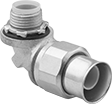How to Identify and Measure Fittings
Pipe size is an industry designation, not the actual size. View information about how to measure threaded and unthreaded pipe and pipe fittings.
More
About Conduit
More
Fiberglass Pipe for Corrosive Chemicals
- For Use With: Acetic Acid (75%), Alcohol, Calcium Chloride, Chlorine, Fuel Oil, Gasoline, Hydrochloric Acid (37%), Nitric Acid (10%), Oil, Phosphoric Acid, Salt Water (30%), Sodium Hydroxide (50%), Sulfuric Acid (70%), Water
- Temperature Range: 32° to 200° F
- Specifications Met: ASTM D2310, ASTM D3567
With excellent corrosion resistance, this pipe can handle a wide range of acids and other highly-corrosive chemicals. Use in metal surface treating applications, plating solution lines, and other chemical process applications. Layers of fiberglass give this pipe better strength and durability than any of our other pipe for chemicals. Pipe meets ASTM D2310 and ASTM D3567 specifications and testing requirements for product dimensions, performance, and material quality.
To connect fittings to pipe, first sand the inside of the fitting and the end of the pipe to remove the surface finish. Next, mix the adhesive (sold separately) until the color is uniform with no streaks. Apply a thin layer of mixed adhesive to the sanded area of the pipe, approximately 1/8” thick. Repeat this process with the inside of the fitting, applying a layer approximately 1/16” thick. After sealant has been applied, push the fitting onto the pipe until it is fully engaged. Finally, use the adhesive-curing heat cable (sold separately) to cure the adhesive. Wrap the tape around the pipe and fitting at the joint, taking care to not overlap the tape. Once you have waited the full cure time, the pipe and fitting will be ready to use.
Warning: Never use plastic pipe fittings and pipe with compressed air or gas.

| Voltage | Current | Max. Heat Output, °F | Lg. | Wd. | Thick. | Plug Type | Cord Lg. | Each | |
| 120V AC | 15 A | 270° | 6 ft. | 1" | 1/8" | Two Prong | 6 ft. | 0000000 | 0000000 |
Continuous-Flex Liquid-Tight Plastic Conduit


Also known as Type A, this conduit meets the demands of continuous motion while sealing out liquid when used with liquid-tight fittings. A layer of nylon provides strength during flexing. This conduit is crush and abrasion resistant as well as flame retardant. It also resists oil, chemicals, and UV light.

One end twists into a piece of conduit for a quick connection; the other end attaches to a knockout in an outlet box or enclosure. These fittings seal out liquid when used with continuous-flex liquid-tight plastic conduit.
Steel fittings are stronger than acetal.
Conduit Connection | Electrical Box Connection | ||||||
|---|---|---|---|---|---|---|---|
| Conduit Trade Size | Conduit Connection Type | Gender | Pipe Size | Thread Type | Gender | Each | |
Steel | |||||||
| 2 | Twist-In | Female | 2 | NPT | Male | 0000000 | 0000000 |

One end twists into a piece of conduit for a quick connection; the other end attaches to a knockout in an outlet box or enclosure. These fittings seal out liquid when used with continuous-flex liquid-tight plastic conduit.
Steel fittings are stronger than acetal.
Conduit Connection | Electrical Box Connection | ||||||
|---|---|---|---|---|---|---|---|
| Conduit Trade Size | Conduit Connection Type | Gender | Pipe Size | Thread Type | Gender | Each | |
Steel | |||||||
| 2 | Twist-In | Female | 2 | NPT | Male | 0000000 | 0000000 |


























